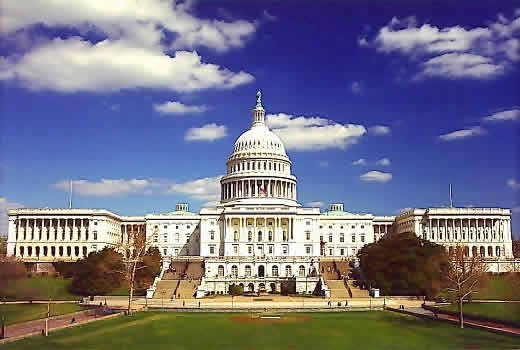The Myths and Realities of Bipartisanship in D.C.

In a 1997 television interview with PBS, former House representative Lynn Martin was asked how important she considered bipartisanship to a government, and to the country. "Sometimes very important, sometimes not important at all. It's obviously flavor of the month right now in Washington because it sounds so nice," responded the Republican from Illinois. Perhaps she should have said flavor of the decade. As has been the case with many recent presidential elections, Barack Obama campaigned heartily last year on the promise of renewed bipartisanship in Washington. He would appoint Republicans to his cabinet, he said — and did, in the form of incumbent Secretary of Defense Robert Gates — and change party dynamics in Congress. For all the election rhetoric, though, is today's government really so fractured? "The current House and Senate are the most polarized since the Civil War," says Keith Poole, professor of political science at the University of California, San Diego. Other pundits aren't so sure. The current Congress might even be — gasp — one of the most bipartisan in recent history, but only in a few categories such as foreign policy, some experts say. Despite differing party ideologies, politicians have "reached across the aisle" to varying degrees over the years and probably get along more than we think, many historians agree. Getting along Bipartisan cooperation between Democrats and Republicans doesn't have an especially long history, but only because the parties themselves hadn't yet gelled into their modern incarnations until just before the Civil War. There were no political parties at all when George Washington was president, and the 1832 presidential election saw four candidates running, all for the same party — the Democratic-Republican (seems almost fantastical, doesn't it?). The Democratic Party eventually sprung from that hybrid, and when the Republicans were cobbled together in 1854 from the remnants of the Whig Party and various others, it began the modern age of de facto two-party politics in the United States. Ideologically very distinct after the Civil War, toeing the party line was the fashion among Democrats and Republicans in the late 19th century, though there were some hints at cooperation. Mr. Republican himself, Abraham Lincoln, appointed a Democrat to the influential position of Secretary of War, and chose another — future president Andrew Johnson — as his running mate in 1864. As the two party platforms gradually made their way towards the middle of the spectrum in the early part of the 20th century, Democrats and Republicans found more ways of working together, experts say. The Golden Age of bipartisanship arrived in the 1930s with the Depression and World War II. Franklin Roosevelt appointed not one, but two prominent Republicans to major positions within his war cabinet, both of whom staffed their departments with more card-carrying members of the GOP. Harry Truman and Dwight Eisenhower were also known for reaching out to their respective opposing parties to pass important legislation related to the Marshall Plan, the controversial aid package that helped rebuild Europe after the war. Bipartisanship "does not involve the remotest surrender of free debate in determining our position. On the contrary, frank cooperation and free debate are indispensable to ultimate unity," said Republican Sen. Arthur Vandenberg, a famous legislative partner of Truman’s, in 1952. There was constant debate over policy between the two parties throughout the 1950s and 1960s, but always with an underlay of camaraderie, historians say. Partisan bickering blown out of proportion? Democrat and Republican relations began to splinter, however, in the 1960s. The Vietnam War and civil rights votes tested allegiances, while the Watergate scandal in the 1970s led Democrats to distance themselves further from the party of Richard Nixon. Things got progressively nastier on Capitol Hill, as a result. Politicians who crossed party lines became the exception. In those decades, partisan bickering also began to get blown out of proportion by the increasingly sensational news media, Martin said. "I think we're forgetting something else that's very different today, and that's if suddenly every member of Congress and president and the president's staff — as difficult is this to believe — all became dear and nice, we'd still be watching screaming matches on television; we'd still be reading in the newspapers awful, dreadful things," she said in 1997. The way Congressmen and women began to campaign in the 1970s through the 90s made the relationship between Democrats and Republicans seem more cantankerous, even when they were aligned in their actual voting patterns, added former Republican Sen. David Pryor. "I think that it is the civility that worries me so much more than the rising statistics of partisanship votes in the past twenty or thirty years in the House and Senate. It's the lack of civility or the growing incivility," Pryor said in that same PBS interview. "Thirty years ago we would never think of going into a state and campaigning against one of our colleagues, for example, who's our seat mate maybe at the lunch counter or down in the senate dining room," he continued. Though the Congress currently sitting in Washington, D.C., seems to have grown even further apart, according to a voting map created by Poole, partisanship might still be exaggerated by the media. Indeed, though ideologies may seem more dissimilar than ever, on the most controversial votes of recent years — the invasion of Afghanistan, the Iraq War, the Patriot Act, the Bailout Bill — the White House got more than enough and sometimes overwhelming support from its Democratic "rivals."
- Video - Finding George Washington: Truths Revealed
- Quiz: The State of the United States
- History Today Archive
Get the world’s most fascinating discoveries delivered straight to your inbox.



